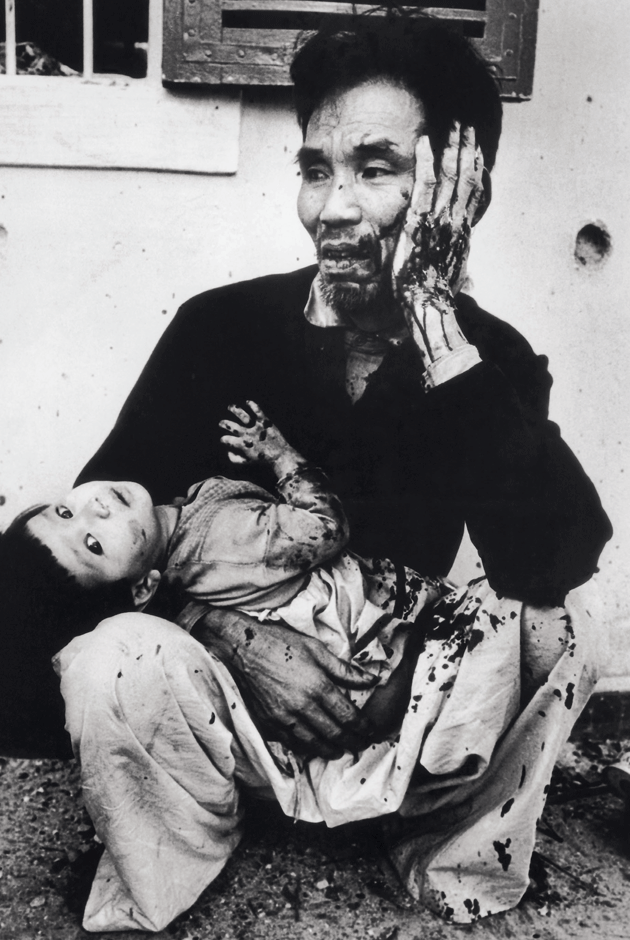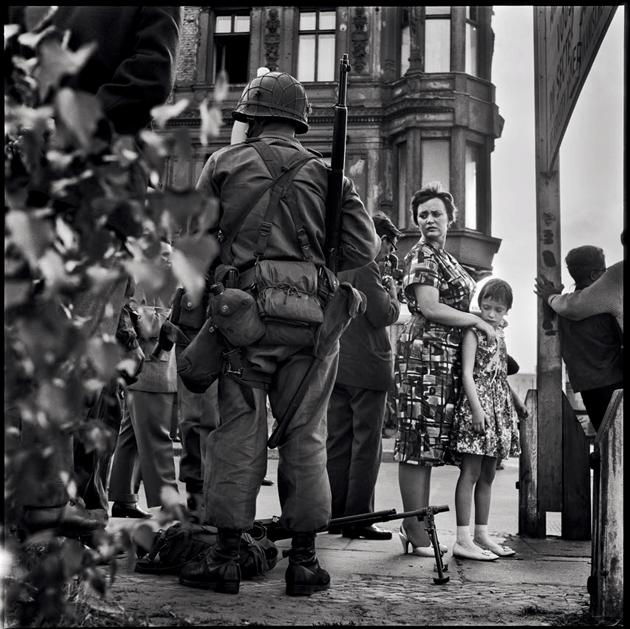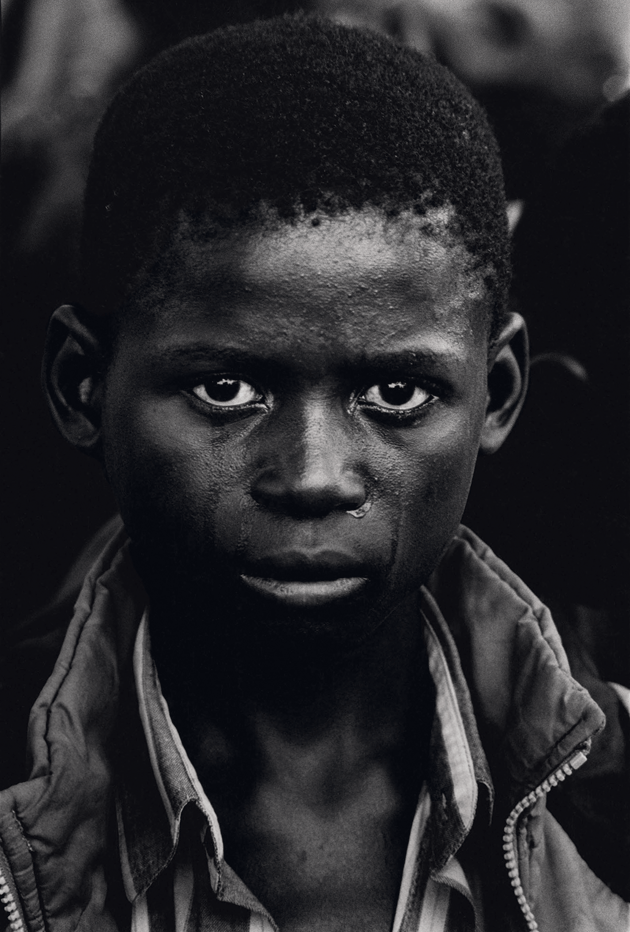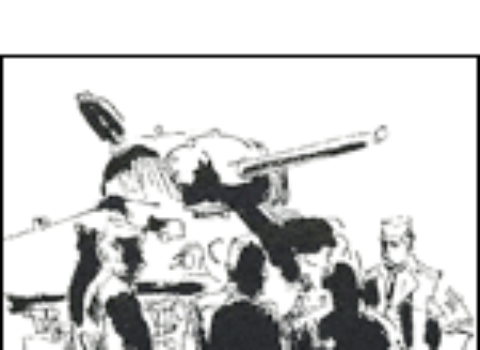There were no civilian cars on the streets of Mosul, Iraq, last December, when the veteran war photographer Don McCullin and I hitched a ride in an Iraqi Army pickup. A few children smiled and flashed V signs at us, but the adults’ stares betrayed hostility or, at best, caution. If Islamic State fighters returned, anyone seen consorting with the army would be punished.
The soldiers took us to an abandoned house in Hay Tahrir (“Liberation Quarter”), a working-class neighborhood in the northeast. Islamic State fighters had only recently been expelled from the area. A blanket was tacked up over the doorway, and daylight came in through the mortar holes in the walls. We dropped onto the dirty floor, folding our legs bedouin-style. The soldiers offered us tea, which had been brewing on a gas burner.
The Iraqis asked McCullin how old he was. Eighty-one, he said. Did he have children? Four boys and a girl. One soldier asked permission to marry his daughter. McCullin told him he couldn’t afford the dowry. After more banter, the soldiers agreed to let us stay the night and go with them to the front in the morning.
A few minutes later, an Iraqi Army Humvee screeched up to the building, and an officer ordered us to accompany him to a forward command post. The brass had discovered that we were in town without permission. Just a month earlier, the Iraqi Army had been welcoming journalists, boasting of victories against the militants, but there was no boasting now. It was the wrong time to be covering the Battle of Mosul.
The Humvee tore over fields and potholed roads littered with stonework from demolished houses, and brought us to a street lined with lavish villas. A massive, armored military truck blocking the street’s entrance reversed to let us through and then resumed its position — it was there to keep out suicide bombers. Inside a clean single-story house, Major Salam, a media officer for the Special Operations Forces, demanded to know how we had entered Hay Tahrir. We admitted that his men had brought us, and attempted to convince him of the public’s right to know what was going on. The major was unimpressed and ordered us out of the city.
We were climbing into the Humvee when a soldier rushed out and hustled us back into the villa — a suicide bomber was heading our way. There was an eerie silence as we awaited the all clear, and then a massive explosion. Blast waves ripped through the air, rattling the windows. McCullin, who had photographed Vietnam, Biafra, and twenty other wars, told me he had never heard a detonation like it. A soldier explained that it was a double blast — rocket and car bomb. McCullin wanted to photograph the burning car, but the soldiers would not let him near.
I looked at McCullin. He was furious. Until that moment, he had been as thrilled as a teenager on his first date. That was his usual mood in this kind of situation. I had seen it before: with Eritrean guerrillas in 1975, Palestinian commandos in 1976, Kurdish peshmerga fighters in 1991 and 2003, and Shiite Hashd al-Shaabi militiamen in 2015. A makeshift barracks was his milieu.
McCullin was already known as the Goya of modern conflict photography when I first met him, in 1975. We were in Khartoum, Sudan. He had just arrived from Beirut, disgruntled at his failure to organize a trip to shoot an insurgency in Yemen. At thirty-nine, he was lean and tough, ready to fight at any suspected insult. In a wistful voice, he confessed that he missed being the youngest journalist on a story. His way to keep going was to better himself, not to compete with anyone or settle.
McCullin was a son of the Blitz, evacuated as a five-year-old from the German bombing of London to a series of wretched farms. His father died young of respiratory illness, and his mother was a tough fighter for her three children. After compulsory military service in Kenya, Cyprus, Yemen, and Egypt, where he failed the Royal Air Force’s photography test, he bought a Rolleicord for thirty pounds and began taking pictures of the Guv’nors, his hooligan friends in Finsbury Park. The group was suspected in the murder of a policeman, and he sold one of the photos to the Observer for fifty pounds. In 1961, he traveled to Germany to photograph the building of the Berlin Wall and got a taste for working abroad. In 1964, the newspaper assigned him to cover his first war — Britain’s suppression of the Greek insurgency. Eventually, he moved to the Observer’s rival, the Sunday Times, at a time when its editor, Harold Evans, was producing the best journalism in Britain.

Top: A man with his two sons, one of whom lost a leg in a scrapyard accident, Bradford,
England, 1978. Bottom: A food-distribution center, Biafra, Nigeria, April 1968
His career often took him away from home. He had three children with his wife, Christine; when she died of cancer in 1988, they were separated, but McCullin was still at her side. Then, a few months later, his girlfriend left him when their son was just two. Don, who never hid his good or bad moods, reached an all-time low — there were long days in the darkroom, longer nights drinking beer. In Unreasonable Behaviour, the autobiography he published in 1990, he bade farewell to the war coverage that had made his career. In a subsequent edition of the book, he wrote,
Work on the autobiography also constituted a kind of healing. It gave some much-needed coherence to my life at war and also, as I then thought, sealed its closure. Readers were informed that those days were well behind me.
They were not behind him for long. “Soon after finishing the original version of this book,” he wrote in the memoir’s updated edition, “I was sitting at home in Batcombe vaguely wondering what to do next when the phone rang.” I remember that call, because I made it. It was March 1991. The United States was expelling the Iraqi Army from Kuwait, and the Kurds were about to rebel against Saddam Hussein’s forces in northern Iraq. It didn’t take long to persuade McCullin to join me, and a few days later we were paddling across the Euphrates.
The Kurds took us from town to village to town on their southward advance toward the oilfields of Kirkuk. Their plan was to go on to Baghdad, where they would join up with rebellious Shiites from the south to overthrow Saddam. Kirkuk, though, was the farthest they got. Three weeks into the revolt, the United States granted Saddam permission to deploy helicopter gunships.* Don wrote,

A man holds his daughter, who was wounded in a grenade attack during the Tet Offensive, Hue, Vietnam , February 1968
That evening, Charlie and I stood high up on a hotel balcony taking in the miracle of a Kurdish-held Kirkuk. Then the gunfire started. Thousands of tracer bullets came streaming in. These great armadas of deadly incoming lighted steel were the clearest possible announcement that the Iraqi Army had not gone very far. Charlie turned to me and said, “Time to go.”
That was the best of the many trips we made together. “I was able to photograph an amazing battle at the railway station, and there were images to be taken of the debris left behind by the fleeing Iraqi soldiers,” Don wrote, “broken vehicles, crumpled weapons and equipment, and even, bizarrely, discarded uniforms.”
Last year, McCullin spoke to the Financial Times about his guilt at exploiting the suffering of others. “I used to combat that morally indefensible position by risking my life,” he said. “I’d go further than anybody else. When you see your own blood, you feel that you’ve been exonerated . . . you’re not a creep, you’re not leeching.”
Back home, he retired from war again, this time, he said, for good. Then, in December 2002, he received “another of those Lucifer-like telephone calls from Charlie Glass.” The United States had launched a new war against Saddam Hussein. I was already in Iraq. McCullin assured his new wife, Catherine, that he would be home with her and their newborn son in two weeks. He returned two months later.
Over the next decade, McCullin did some work at home, but war remained his passion. So in December 2016, he was eager to go to Mosul to document the city’s “liberation” from the Islamic State. But our trip didn’t go as hoped. The Iraqi military had banned reporting from inside the city, and our best attempts to circumvent it — pulling strings, calling in favors, lying at checkpoints, flattering a heavy-drinking general — got us nowhere.
How long could we wait? How many futile attempts would we have to make to enter Mosul? In Erbil, Fuad Hussein, the chief of staff to the president of Kurdistan, told us, “Mosul will be liberated, but don’t ask me when.” The coalition’s American spokesman, Colonel John L. Dorrian, pointed out that “Mosul is five times the size of Ramadi, and Ramadi took six months.” McCullin had had enough. We went home to spend Christmas with our families.
The press ban remained in force until late January, when Hussein sent me an email: “The eastern side [of Mosul] today has been completely liberated.” The war was not over — on the west bank of the Tigris, the Islamic State was dug deep into the midst of 750,000 civilians — but the media could return. In July, the Iraqi Army declared victory over the Islamic State in the city. McCullin could have gone back to Iraq to document the new part of the assault, but after the frustrations of the previous trip, he said he would never go back.
Of course, he’d said that before.










